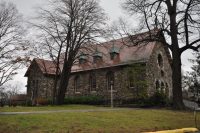Good Counsel Complex Receives Landmark Status – Development Plans Continue

During the May meeting of the White Plains Common Council, the Draft Environmental Impact Statement (DEIS) of April 2018 regarding a change in the city’s Zoning Ordinance to create a new Planned Residential Development District and to place property located at 52 N. Broadway, also known as the Good Counsel Complex, into that district was accepted by the Council as complete.
A public hearing on the DEIS was set for June 4.
The new owners of the property, WP Development NB, LLC, had proposed the amendment to accommodate density changes in the residential makeup of the property as well as floor-to-area ratios of new buildings and changes in setbacks and side yards.
Councilmembers Dennis Krolian and Milagros Lecuona both voted against accepting the DEIS. Krolian noted that earlier during the same meeting the Council had approved a new TD-1 Transit Zoning District that would include hundreds of new residences just down the street from N. Broadway.
Lecuona said she was 100 percent certain the new units proposed nearby and traffic impact had not been addressed. She was also concerned about landfill remediation on the property as well as landmark status of the site.
The DEIS as submitted in April 2018 contains an alternative site layout including preservation of the westernmost wing of the historic convent building along with the preservation of the Chapel of the Divine Compassion and relocation of the Mapleton House.
The multi-family buildings using the alternative layout have been reduced from 400 to 370 dwelling units and reduced in height by 30 feet from 10 to 8 stories. The assisted living facility is reduced from 90 to 82 units in a narrower four-story building with a smaller footprint than the original two-story cruciform building proposed. And, the academic housing has been reduced from 70 to 50 suites and moved to the extreme northeastern corner of the site.
During the same meeting a resolution to veto the White Plains Historic Preservation Commission’s unanimous recommendation that 13 acres on the 16-acre site, including 10 buildings, be declared a local landmark was put forward and rejected.
Councilmembers John Kirkpatrick and John Martin expressed legal concerns over the procedure of adopting landmark status of the property before the full SEQR (State Environmental Quality Review) process was complete as well as specific wording defining the property that could cause future problems.
Both Kirkpatrick and Martin said they supported historic preservation of the site and its buildings, but were concerned about challenges.
The remaining councilmembers disagreed and voted to reject the veto.
Mayor Tom Roach explained that the Historic Preservation Commission is an independent entity and that by not vetoing the Commission’s decision on landmark status, the Council was upholding its decision.

